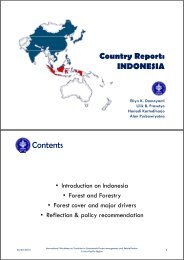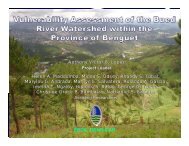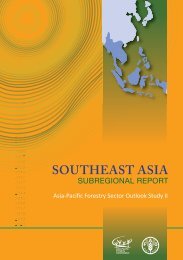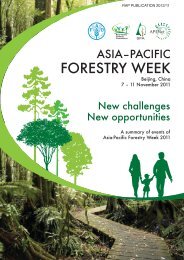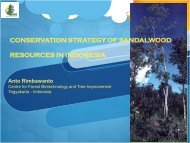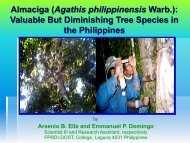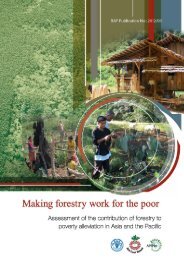Community guidelines for accessing forestry voluntary carbon ... - FAO
Community guidelines for accessing forestry voluntary carbon ... - FAO
Community guidelines for accessing forestry voluntary carbon ... - FAO
Create successful ePaper yourself
Turn your PDF publications into a flip-book with our unique Google optimized e-Paper software.
<strong>Community</strong> <strong>guidelines</strong> <strong>for</strong> <strong>accessing</strong> <strong>for</strong>estry <strong>voluntary</strong> <strong>carbon</strong> markets<br />
1. Additionality<br />
The <strong>for</strong>estry VCM does not reward activities that have already started or<br />
have already been planned. The test of additionality is satisfied if these<br />
activities, and the resulting emission reductions, will only happen as a<br />
result of participation in the <strong>for</strong>estry VCM. There are tools available to<br />
test the additionality of a project, <strong>for</strong> instance on http://cdmrulebook.<br />
org/658.<br />
2. Leakage<br />
A <strong>for</strong>estry VCM project must demonstrate that it has minimized leakage,<br />
and has accurately quantified any leakage that does occur. Leakage may<br />
cancel out the benefits from a <strong>for</strong>estry VCM project, or even result in<br />
a net increase in emissions. In this case, a project cannot be credited,<br />
even if the source of leakage is beyond the direct control of the project<br />
manager.<br />
3. Permanence<br />
Carbon stored in <strong>for</strong>ests can be released again. This has always been a<br />
great concern <strong>for</strong> negotiators under the KP. Under the CDM, this issue<br />
was addressed by issuing credits that have a validity of only five years,<br />
after which they expire and the project must go through a verification<br />
process again. The VCS, by contrast, uses a ‘buffer tool’, whereby credits<br />
that are at risk due to permanence-related issues, are placed in a buffer<br />
and cannot be traded. As time moves on, and as risks do not occur,<br />
credits are released from the buffer and can be sold.<br />
Guidance <strong>for</strong> the VCS buffer tool is available at: http://www.v-c-s.<br />
org/sites/v-c-s.org/files/AFOLU%20Non-Permanence%20Risk%20<br />
Tool%2C%20v3.1.pdf<br />
64




